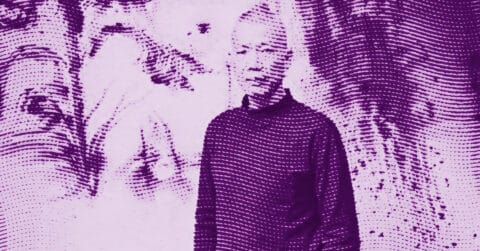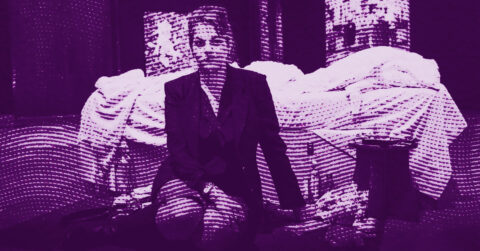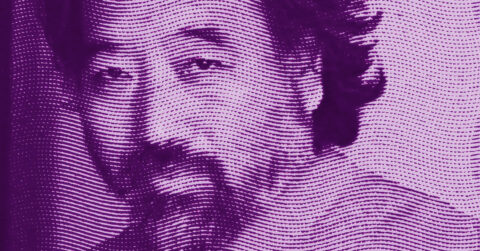Listen to me carefully, you bunch of snobs, I am going to tell you something about John Currin that no one dares articulate clearly: he is the Marquis de Sade of upscale galleries. A demented emperor who reigns over a kingdom where beauty and ugliness intertwine in a macabre dance. His paintings are luminous abscesses, phosphorescent wounds that bleed a mixture of oil paint and corrupted male desire. And I love it.
Currin’s works provoke that strange sensation where disgust is immediately followed by an uncontrollable fascination. It’s the feeling that invades you when you slow down to look at a car accident or when you can’t look away from a horrible video on the internet. Currin’s work is precisely that: a magnificent accident between Western pictorial traditions and our most unavowable impulses.
Currin became famous in the 1990s with his portraits of women with absurd proportions. These women with disproportionate breasts, these distorted faces, and these bodies with improbable shapes have become his signature. Kim Levin, a critic at the Village Voice, had called for a boycott of his first exhibition in 1992. What a mistake! It was like asking to boycott a mirror that reflects our own monstrosities. Because what Currin does is more subtle and infinitely more disturbing than a simple provocation: he crystallizes in his painting the male angst in the face of femininity.
The way Currin manipulates art history evokes what Mikhail Bakhtin [1] called the “carnivalesque”, that temporary suspension of established hierarchies where the sublime and the grotesque coexist without distinction. As Bakhtin wrote in his analysis of Rabelais, “the carnival celebrates the provisional liberation from the dominant truth and the existing regime.” This theory of the carnivalesque applies perfectly to Currin’s work, where traditional aesthetic canons are simultaneously celebrated and ridiculed.
Take, for example, his painting “Mantis” (2020). A woman with a serene, almost angelic face is perched on another woman lying down, the two forming a hybrid creature half-insect, half-nymph. Their deformed bodies evoke circus contortionists or fairground acrobats. But they are painted with the technical precision of a Pontormo or a Cranach. This deliberate mixture of classical virtuosity and contemporary vulgarity seems to tell us: “Look at what I can do with my brushes, and look at what I choose to do with them.”
Currin’s painting technique is undeniably impressive. He paints like an old master who has absorbed five centuries of art history to regurgitate them in a strange and personal synthesis. His luminous glazes, his nacreous flesh, his meticulous draperies, all testify to a mastery that makes his thematic choices even more destabilizing. He uses a technique that has served to represent Madonnas and saints to paint characters drawn from 1980s Scandinavian porn cinema.
This cognitive dissonance between the “how” and the “what” of his painting is precisely what makes his work so captivating. It’s like hearing Mozart played on a kitchen batterie, or Racine recited by a clown. The contrast between form and content creates a tension that is never completely resolved.
In his “Memorial” series of 2021, Currin pushes this dissonance to its paroxysm. Naked women in pornographic poses are represented as marble statues in architectural niches. Female bodies, traditionally objects of the male gaze in art history, are here literally petrified, transformed into commemorative monuments of a desire that knows itself to be doomed. They are flesh phantoms frozen for eternity in obscene attitudes, like the calcified bodies of Pompeii.
What Currin understands better than anyone is that Western figurative painting has always been a vehicle for male desire. From Titian’s Venuses to Ingres’ odalisques, art history is full of female bodies offered to the gaze. By exposing this tradition with brutal frankness, Currin forces us to look straight at what we would prefer to ignore. As Susan Sontag [2] writes in her essay “Regarding the Pain of Others”: “Images that mobilize consciousness are always linked to a specific historical situation. The more general they are, the less effective they are.”
Currin’s paintings are not general, they are specific and historically situated in our era of the overabundance of pornographic images, cosmetic surgery, and identity confusion. They are effective precisely because they show us what we do not want to see: our own complicity in the reduction of bodies to objects of consumption.
But make no mistake: Currin is not a moralist. He is himself implicated in what he criticizes. His paintings do not come from a place of moral superiority, but from a recognition of his own participation in the system he exposes. When he paints his wife, artist Rachel Feinstein, with gigantic breasts or in suggestive poses, he does not pretend to be above the fray, he admits to being part of this economy of gaze and desire.
This honesty is refreshing in a contemporary art world often dominated by a self-righteous stance. Currin does not hide his impulses behind impenetrable theoretical discourse. He spreads them out on the canvas with disarming frankness. As Camille Paglia [3] observed: “Art is not a purified sphere. It is an arena of chaotic tensions where Apollo and Dionysus, form and dissolution, confront each other.”
Critics have often labeled Currin as misogynistic, but this label is reductive. It would be more accurate to say that he paints misogyny rather than embodying it. His paintings are anthropological documents that record male fantasies in all their absurdity. He does not glorify these fantasies, he exhibits them, dissects them, pushes them to their logical breaking point.
Consider “The Bra Shop” (1997), with its women with grotesquely exaggerated breasts, or “Nice ‘n Easy” (1999), sold for 12 million dollars in 2016. These works do not celebrate the objectification of women, they reveal the ridiculousness of this objectification. The faces of these women, painted with a thick, granular texture that evokes acne, violently contrast with their smooth, idealized bodies. This juxtaposition creates an effect of alienation that prevents us from consuming these images without reflecting.
The parallel with cinema is enlightening. If the films of Russ Meyer or Paul Verhoeven stage hypersexualized female bodies, it is to expose the mechanisms of the male gaze rather than to reinforce them. The same goes for Currin. His paintings are deforming mirrors that reflect our own desires in all their monstrosity.
This approach finds an echo in Laura Mulvey’s film theory on the “male gaze”. In her seminal essay “Visual Pleasure and Narrative Cinema”, Mulvey analyzes how traditional cinema structures its visual language around male scopophilic pleasure. Currin, by taking up the codes of this gaze but pushing them to the point of absurdity, manages to subvert them from within.
There is something profoundly American in Currin’s work. His mixture of irony and sincerity, of technical virtuosity and assumed vulgarity, reflects the contradictions of a culture constantly oscillating between puritanism and exhibitionism. As Scott Fitzgerald wrote: “The test of a first-rate intelligence is the ability to hold two opposed ideas in mind at the same time and still retain the ability to function.”
This fundamental ambivalence explains why Currin’s paintings can sell for astronomical prices while continuing to shock. They perfectly embody the tensions of our time, where political correctness coexists with a thriving pornographic industry, where woke sensitivity rubs shoulders with an openly misogynistic president.
For that is precisely what it is about: Currin paints the America of contradictions, the America of simulacra, the America that claims to defend freedom while repressing desire. His women with impossible proportions are the inhabitants of this schizophrenic country, torn between its puritanical ideals and its mercantile impulses.
A work like “Sunflower” (2021) perfectly illustrates this tension. A seated woman, her body emaciated but with disproportionate breasts, holds a wilted flower. Her face, with empty eye sockets, looks down as if to avoid our gaze. She is both victim and accomplice, object and subject. This moral ambiguity is at the heart of Currin’s project and explains why his paintings resist any simplistic interpretation.
The bodies in Currin are never neutral, they bear the marks of history, of collective desires, of cultural anxieties. In this sense, his work joins that of other American artists who have explored national mythologies, such as Edward Hopper or Cindy Sherman. But where Hopper found poetry in urban solitude and Sherman deconstructed feminine stereotypes, Currin tackles head-on the question of visual pleasure and its complicity with structures of power.
What makes Currin’s work so powerful is its ability to involve us emotionally. One can detest his paintings, find them vulgar or offensive, but one cannot remain indifferent. They provoke a visceral reaction that goes beyond aesthetic appreciation. They make us feel something: disgust, desire, discomfort, fascination, and that is perhaps the very definition of art that matters.
So yes, Currin is the Marquis de Sade of painting, enjoying his power to shock while mastering perfectly the codes he transgresses. But he is also a lucid observer of our time, a chronicler of the fantasies that structure our collective imagination. And in a world saturated with smooth and formatted images, this brutal honesty is more precious than ever.
- Bakhtin, Mikhail. The Work of François Rabelais and Popular Culture in the Middle Ages and the Renaissance. Gallimard, 1970.
- Sontag, Susan. Regarding the Pain of Others. Farrar, Straus and Giroux, 2003.
- Paglia, Camille. Sexual Personae: Art and Decadence from Nefertiti to Emily Dickinson. Yale University Press, 1990.
















